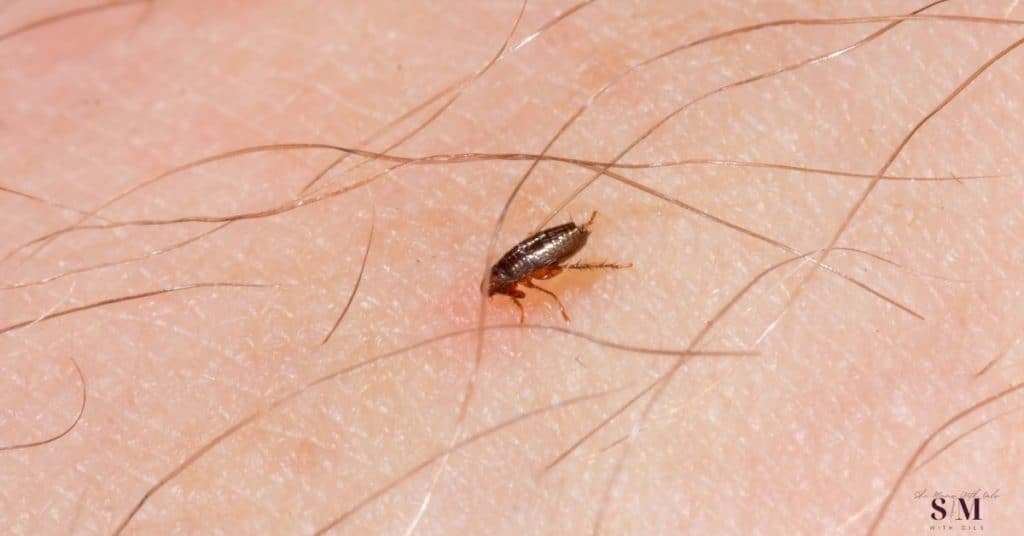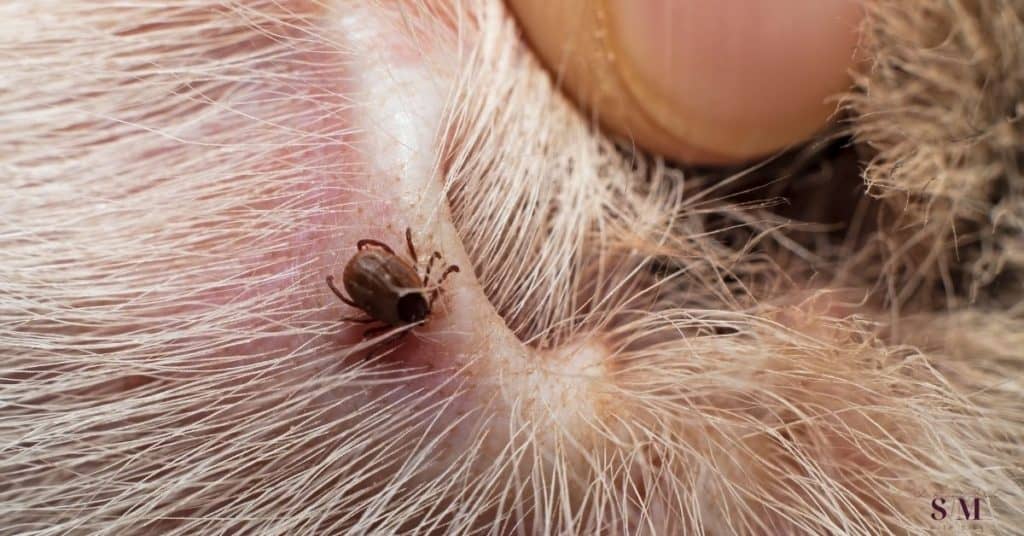HOW TO KILL FLEAS AND TICKS NATURALLY
How to kill fleas and ticks naturally.
You can get rid of a flea and tick infestation naturally using:
- A flea comb;
- Apple cider vinegar;
- Coconut oil;
- Rosemary leaves;
- Lemon juice;
- Essential oils.
Read this post to learn exactly how.

The following post may contain affiliate links, which means I’ll get a small commission if you decide to buy using the links provided. This will add NO EXTRA COST to you but it helps me to keep this blog up and running. Thank you. You can get more info by reading my Disclaimer page.
How do you kill fleas and ticks naturally?
If you are a dog owner, chances are you are doing your best to prevent a flea and tick infestation on your little furry friend.
Fleas and ticks are indeed common pests, and your animal can get infested at any stage.
Good news is that even if your pet does get infested, there are several remedies to kill fleas and ticks naturally.
IMPORTANT
Always follow the advice of your trusted vet before using any product on your pets.
While essential oils and natural ingredients such as coconut oil are generally safe for dogs, some animals might be sensitive to some ingredients, or might develop an allergic reaction. Immediately stop any treatment if you notice any reaction, such as a skin irritation on your dog. Seek immediate help from your local vet if you are concerned about your pet’s health at any stage.
The same advice applies to you and the rest of your family. Although the natural ingredients used in the recipes below are generally safe, always consult with your doctor before using any product. Pay particular attention if you suffer from any condition, allergy or if you are pregnant or breastfeeding.
Seek immediate advice and help from your trusted medical care provider if you are concerned about your health or that of your family.
Subscribe to my YouTube Channel!
If you’d rather watch a video, you can watch on my Youtube channel!
Don’t forget to pin the post for later!
WHAT ARE FLEAS?
The description of what fleas are is in enough to give you nightmares!
According to www.britannica.com “flea, (order Siphonaptera), any of a group of bloodsucking insects that are important carriers of disease and can be serious pests. Fleas are parasites that live on the exterior of the host (i.e., are ectoparasitic). As the chief agent transmitting the Black Death (bubonic plague) in the Middle Ages, they were an essential link in the chain of events that resulted in the death of a quarter of the population of Europe. […] Fleas are small, wingless insects with a tough cuticle bearing many bristles and frequently combs (ctenidia) of broad, flattened spines. The adult flea varies from about 0.1 to 0.32 cm (0.039 to 0.13 inch) in length and feeds exclusively on the blood of mammals (including humans) and birds.

Charming, right?
HOW DO I KNOW IF MY DOG HAS FLEAS?
If you suspect your dog might have fleas, it is very important to check as soon as possible. In fact, a flea infestation can have serious consequences for your pet, as well as for your family, if left untreated.
There are several signs to look for in order to establish if your dog has fleas.
Generally speaking, your dog will feel excessive itching and consequently will scratch a lot.
Moreover, you might be able to see fleas on your pet, or notice “flea dirt” (flea faeces) on it.

what is flea dirt?
Flea dirt, also known as flea faeces, is the waste left behind by these insects.
It presents as brownish or black dirt, easily mistaken for regular dirt from the soil.
A way to check if your dog has flea dirt, is to run it under water. Flea dirt will turn red when exposed to water.
How do I detect fleas on my dog?
Spotting fleas is not that hard. They are tiny wingless bugs, normally brown or black in colour.
However, you could use a “flea comb” to make the task a little easier.
Also, you could grab a piece of cotton cloth, wet it slightly with water, and gently dab your pet’s skin with it or its bedding. You will see fleas or flea dirt on it, in case of an infestation.
what is a flea comb?
A flea comb is a handy tool to have if you are a dog owner. They work similarly to a lice comb for humans.
You could get a flea comb at your local pet store, or online.
WHAT IS THE FLEA LIFE CYCLE?
I found the answer to this question on the CDC website: “Most fleas have four life stages: egg, larva, pupa (in a cocoon), and adult. […] The lifecycle of fleas can be very quick or last many months to years depending on the environmental conditions throughout the life stages.”.
This is how the CDC (the centre for disease control of the United States) website describes the life of a flea:
- After finding an animal or human host and taking a blood meal, adult fleas will mate and begin laying eggs in the fur and surroundings of the host. Eggs will hatch in one to ten days depending on environmental conditions such as temperature and humidity.
- After hatching from an egg, fleas enter their larval stage. Larvae are free moving and feed on blood and flea faeces (poop; also called “flea dirt”), in order to continue their development.
- Within 5-20 days of feeding on flea dirt, the larvae will spin a cocoon, and enter the pupa stage. The cocoon protects pupa from environmental conditions and insecticides/repellents for several days or weeks until adult fleas are ready to emerge.
- Adult fleas will not emerge from the cocoon until there is a clear presence of a host, such as movement or body heat, which will signal that there is a blood meal readily available.
- Adult females begin to feed from a host within a few hours of emerging from the cocoon and soon after will mate and begin laying eggs.
what are ticks?

Ticks are very little insects responsible for a variety of diseases, such as Lyme disease and Rocky Mountain spotted fever.
Related to spiders, they have 8 legs and are only about the size of an apple seed.
They have flat, and oval shaped bodies that will swell after each feed.
Ticks feed on blood from all animals.
You can read more about ticks on the CDC website.
what is the life cycle of ticks?
The life cycle of ticks consists of four stages: egg, larva, nymph and adult.
Ticks can live up to 2 to 3 years, depending on the species and environmental conditions.
how do i know if my dog has ticks?
Thankfully, after they feed, ticks are big enough to be spotted. If you simply run your hands on your dog’s body, you might feel small bumps on its skin and fur.
Generally speaking, ticks attach to the areas around your dog’s feet, neck, ears and head.
how do fleas and ticks attach to your dog?
Fleas and ticks can survive outdoors for prolonged periods of time, even without a host.
They can be found in shady areas whit tall grass, or among heaps of dead leaves.
Your pet can come into contact with them in your garden, at a day care, in a dog kennel, at the local park, or just when out for a daily walk.
Once an adult female flea or tick attach to your animal, they start to lay eggs almost immediately, thus reproducing very very fast, leading to an infestation in a matter of days.
How do you kill fleas and ticks naturally?
Once you have established that your dog is indeed infested with fleas or ticks, it is very important to start a proper treatment promptly.
As mentioned before, an untreated infestation can lead to serious consequences for your pet and your family.
Your vet will be able to direct you to an appropriate treatment. However, there are several home remedies you could use at home to kill fleas and ticks naturally.
Let’s have a look at some of those.
COCONUT OIL
Coconut oil is well known for its abilities to treat head lice infestations on people.
Along the same line, it can be effectively used to kill fleas naturally.
Just place a little quantity of coconut oil on your hands, and apply on your pet’s fur.
This will not only rid of fleas, but it will leave a pleasant odour on your dog, and a shiny coat.
LEMON WASH
Simply squeeze a lemon, and add half a cup of the juice to two cups of water.
To this diluted juice, add your regular dog shampoo and wash your pet as per normal.
This simple home remedy will help you to get rid of fleas naturally, and will leave a fresh clean smell on your dog.
APPLE CIDER VINEGAR (ACV)
Apple cider vinegar is a very versatile ingredient. Its many uses even stretch as far as ridding your pet of fleas.
To use it safely on your dog, your should dilute six cups of ACV with four cups of water. Pour this mixture in a spray bottle and add just a pinch of sea salt. Shake very well and spray directly on your dog’s coat, being careful to stay away from its face and eyes!
Discard after use.
ROSEMARY RINSE
This is a very simple rinse you can make any time at home. Simply pick some fresh leaves of rosemary and let them gently steep in boiling water for a few minutes.
Remove the pot from the heat, and let it cool down to room temperature.
Pour the rosemary water in a bucket filled with warm water, and rinse your dog thoroughly. Let it air dry.
Always check the water temperature before rinsing your dog, to avoid burns!
FLEE COMB
I have already mentioned what a flee comb is.
This comb is not treated with any chemical, making it an ideal tool to kill fleas naturally.
Brush your dog’s coat daily with this comb to prevent infestations and to get rid of fleas. It is ideal to brush your pet first and then treat it with another natural remedy to increase your chances of success.
IF YOU WANT TO KNOW EXACTLY HOW TO USE A FLEA COMB TO GET RID OF PESTS FAST AND EFFECTIVELY, READ THIS POST FOR STEP-BY-STEP INSTRUCTIONS.
can you use essential oils on dogs?
Essential oils can provide great support for your pets. However, it is very important to remember that some oils can be poisonous for animals.
Always consult with your vet before using any product on your pets.
Dogs in particular have very sensitive noses, and might react differently to different scents.
For this reason, it would be best to test an oil on your dog before using it topically.
Simply apply a drop of an oil or blend on your hands, and let your pet smell it to see how he reacts to it.
THE BEST ESSENTIAL OILS BUG REPELLENT RECIPES
For a complete article on how to use essential oils to prevent fleas and ticks infestations naturally, you can check my post “THE BEST ESSENTIAL OILS BUG REPELLENT RECIPES”.
Here you can find an extensive list of what are the best essential oils to use to repel and treat pests naturally, as well as some DIY recipes!
How do you make homemade flea and tick spray with ESSENTIAL OILS?
Making your own DIY essential oil spray to kill fleas and thicks naturally is very easy.
Just grab a 30ml spray bottle, add a total of 30 drops of essential oils, top with water and mix well. To use, spray on your dog’s paws to prevent further infestations.
To kill fleas and ticks, you can spray some of the blend on a cloth, and massage through your dog’s coat.
ESSENTIAL OILS FLEA COLLAR
Store bought flea collars contain chemicals that might be actually harmful to your pets. For this reason, I always make my own natural version of it using my favourite essential oils.
Use a spray mix as described above, and simply spray on your dog’s collar. Alternatively, you can spray a little cotton bandana and place it over your pet’s collar. Both solutions will work.
It is very important to ensure you do not spray directly onto your pet’s face!
HOW LONG DOES IT TAKE TO GET RID OF FLEAS AND TICK?
Unfortunately there is no straight answer to this question.
A lot depends on your circumstances. For example, it depends on:
- how long your pet has been infested;
- the number of pets you have;
- how you are treating your environment (your home).
Generally speaking, it might take anything from a couple of days to a couple of weeks. Just like a head lice infestation, the key is to be persistent, and keep up the treatment till the issue is resolved.
HOW TO KILL FLEAS AND TICKS NATURALLY STEP BY STEP
In order to get rid of an infestation, there are several steps you should follow.
Remember to always wear gloves when handling your pet and any object he might have been in contact with.
Ask a member of your family to help you with this chore if you are pregnant or breastfeeding. Better safe than sorry!
- Comb through your pet’s coat, using a flea comb. This will get rid of some of the fleas and ticks already. Pay particular attention to the neck area and the base of the tail;
- Wash your pet adding a couple drops of essential oils to its regular shampoo, or using lemon juice (see recipe above);
- Apply your chosen topical treatment;
- Spray your dog’s collar with a mix of essential oils (see my recipe above) to boost your chances of success;
- Wash pet bedding in hot soapy water at least every 2 to 3 days.
- Make sure to wash your dog frequently till the infestation is resolved;
- Disinfect your house. As painful as this might sound, you will need to clean your house thoroughly, as fleas and ticks can easily hide in spots such as carpets, rugs, beds, sofas, etc. Unfortunately it can take a long time to get rid of those insects in your environment, as they lay many eggs in short periods of time.
- Try to prevent future infestations. Like in many other cases, prevention is often times the best way to go about a flea and tick infestation.
You can check my DIY recipes to repel many common insects and pests in this blog post here:
What home remedy kills fleas and ticks? Conclusions
Although trying to get rid of fleas and ticks naturally might feel overwhelming, there are many natural home remedies at your disposal.
If you act promptly, you chances of success are indeed very good.
Remember that consistence is key, so don’t get discouraged if you don’t succeed at first.
I hope you will find some of the natural options described in this article helpful.
Please do leave a comment below and let us know what are the natural topical treatments that worked best for you.
Till next time, Dee.
IMPORTANT: when using Essential Oils, make sure to use only CPTG Certified, Pure, Tested Grade ones, like Doterra Essential Oils. The content of this blog post and any information provided here has not been evaluated by any government entity or medical practitioner. It is NOT intended to diagnose, treat, cure or prevent any disease, illness or condition. It is NOT intended to be a substitute for medical counselling. If you are pregnant, breastfeeding, or suffering from any medical condition or illness or injury, you SHOULD consult a qualified healthcare professional before using any product.
IF YOU ARE DEALING WITH PESTS IN YOUR HOME AND WITH YOUR PETS, YOU MIGHT LIKE TO READ THE FOLLOWING POSTS:

The Best Essential Oils Bug Repellent Recipes
How To Kill Fleas And Ticks Naturally
How To Get Rid of Fleas In Your Home Fast Using Natural Ingredients
How To Kill Fleas With Diatomaceous Earth
How Do I Know If My Puppy Has Fleas?
Does Diatomaceous Earth Kill Bed Bugs?
The Best Essential Oils That Kill Bed Bugs
Hi, I’m Dee!
Mom of three; printables creator, natural solutions, simple living and homemade food enthusiast; “Outlander” fanatic.
When I’m not busy writing and designing, you can always find me covered in a cloud of flour in the kitchen, playing and crafting with my children, or making up some blends with my Essential Oils. Also I’m practically obsessed with Crystals and reading during my spare time.
Come along on our crazy journey as a family living in the countryside of Ireland!


